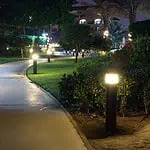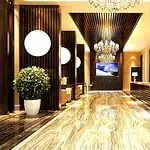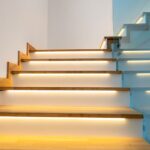Lighting a landscape does not just impart elegance to the property but also increases its value by many folds. However, the moment you start looking for landscape lighting solutions, you will notice that it is quite costly. There are several factors that contribute to the high costs of landscape lighting, which we will break down in this article. This article will discuss some cost-effective solutions for landscape lighting that you can implement in your properties. So, let’s get to it.
What Exactly Is Landscape Lighting?
It is important to know what exactly landscape lighting is to get to the bottom of its expenditure. Like the lights in your bedrooms, the landscape lighting has to be well-thought-out. You have to take the dimensions of the landscape, its elements, and so many other things into account. The purpose of landscape lighting goes far beyond mere illumination. It shows the personality of homeowners, highlights the elements in the landscape, and improves the property’s overall look.
You cannot just install a massive flood light to light the entire landscape. While it will serve the fundamental purpose, it would not exactly be the landscape lighting. You must carefully pick between different light types, fixtures, and other things to light a landscape appropriately.
An appropriately lighted landscape will not just improve its utility of the landscape, but also impart your personality to it. It will leave an impression on anyone who ever visits your property.
Benefits of Landscape Lighting?
There is no denying that lighting a landscape can be expensive and time-consuming, but if it is done right, the benefits will make it all worth it. While you will get various benefits from it, let’s take a look at some of the major ones.
1. Improves Aesthetics of a Property
Talk to interior designers, and they will tell you that lighting in a space is just as important as the elements inside it. While dull lighting can make premium elements look boring and dull, great lighting can bring life into even mediocre pieces. All of it is true for landscape lighting as well. If your landscape has a garden with tall trees inside it, lighting them with appropriate fixtures will turn them into a visual treat. Similarly, there are various options that can turn the swimming pools or ponds in your landscape to look like something straight out of movies.
To put it all in a nutshell, a great landscape attracts visitors and makes them envious of your property.
2. Increases Value of Property
A well-illuminated landscape can increase the value of the property. Imagine walking into a home and seeing a landscape with lighting that enhances every element inside it. And then visited another house that had a landscape, but the lighting was sub-par. Which one of them would be tempted to purchase? The answer is a brainer and evidence of just how much impact lighting has on the value of a property.
It is particularly important for those who want to purchase a home and sell it sometime later to make profits. In addition to some quick repairs, lighting the house’s landscape will significantly impact the property’s overall value.
3. Improves Security
Have you ever left the lights inside the house on while leaving the room in the dark? If not, then you must because it keeps the intruders at bay. Landscape lighting works in similar ways; it adds another layer of protection to your house. It will keep the landscape well-lit, making it hard for intruders to hide while trying to break into the house. While it is not the major function of landscape lighting, having that additional layer of security never hurts.
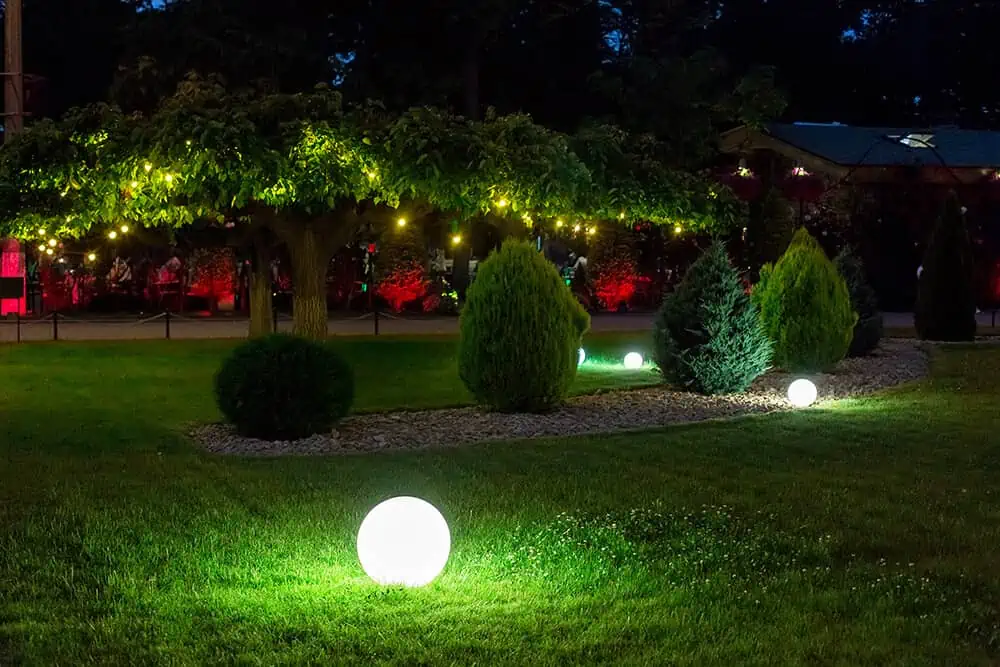
Why is it so Expensive?
The benefits of landscape lighting certainly sound tempting, but it is quite expensive, and that can be a reason to discourage homeowners from going down the road. However, with an understanding of precisely what makes it so expensive, one can navigate around the costs and find an affordable solution. Let’s take a look at some reasons which make landscape lighting as expensive as it is.
1. Materials
The material required for landscape lighting must be high-quality. The fixtures, wirings, and supporting structures have to withstand the harshness of weather. They must withstand extreme heat and extreme cold. Otherwise, the life of landscape lighting will decrease significantly. The market offers specialized landscape lighting materials which check all the right boxes. For example, the fixtures should be water and corrosion-resistant.
The most popular fixture for landscape lighting is made up of cast brass. The most significant benefit of such fixtures is their lifetime warranty. Once you have installed them, you can rest assured that they will not malfunction, at least in your lifetime.
Thus, the cost of producing such a durable fixture is delegated to the customers, which makes landscape lighting expensive.
2. Maintenance
When the expenses of landscape lighting are discussed, we also have to consider the maintenance of such a system. The maintenance of landscape lighting includes a lot more than just changing the bulb when it starts to malfunction. You have to inspect the wiring, look for potential breaks, and examine supporting structures for possible corrosion or rust.
Considering the size of the landscape is generally bigger than the interior, the replacements owing to malfunction can pile up the cost of landscape lighting. However, this particular expense can be reduced by opting for high-quality fixtures, which are discussed in the above section.
3. Design
Similar to hiring professional interior designers to design the interior of your house, you have to hire professionals for the landscape lighting as well. These professionals will examine the landscape and inform you about some designs’ feasibility. You might be tempted to do it all yourself, which is fine, but hiring a professional is always a better call. In addition to discussing different designs, you can also compare different fixture options to make them cost-effective.
So, while hiring professional designers will cost higher upfront, it can save a decent sum in the long run.
4. Installation Costs
Once you have finalized a design, you will feel that implementing that is the easiest of tasks. But it is not the case. In fact, you might be able to make landscape lighting work without hiring a professional designer. Still, you certainly cannot make it secure without hiring a professional service for installation.
The wiring of the landscape lighting is quite complex, and going wrong with it can expose you to several threats, including getting electrocuted. If you hire professionals, they will carefully conceal the wires so that they do not threaten the people strolling the landscape. Furthermore, the professional installation of landscape lighting will also protect the fixtures and other elements against environmental hazards.
The point is without professional installation, the maintenance cost and the overall safety-related risks will increase. Thus, it is better to leave the installation to professionals and save money in the long run without exposing yourself to potential risks.
5. Types of Lights
While browsing for options for landscape lighting, you will come across several types of lights. The most popular of them include incandescent bulbs, halogen lights, and LEDs. If you compare the price of three lights, you will be tempted to go with incandescent bulbs. However, we would not advise that mainly because while incandescent bulbs are affordable, they are not cost-effective. These fixtures not only consume higher energy but also have sub-par durability.
Thus, even though you will pay low prices upfront, the maintenance and replacement of these fixtures will quickly pile up the cost. Not to mention, such solutions will also drive your energy bills significantly.
In contrast, the LEDs cost higher upfront, but they are the most energy-efficient and durable solution ever designed. The initial investment might be higher, but you will reach the breakeven point soon enough. You will start saving a lot on energy bills from thereon compared to using incandescent bulbs.
6. Costs of Particulars
Installation of landscape lighting is more than just purchasing fixtures and hanging them with the elements in the landscape. You will have to buy other things as well, including support structures, tightening equipment, and equipment to install these structures. All of them can cost a lot and drive the price for landscape lighting. You can save some cost by hiring professionals, as that would not require you to purchase tools for professionals.
Furthermore, like the lights, all of these elements have to be sturdy enough to withstand the abuse that harsh weather might throw their way. Thus, you will have to purchase high-quality elements to implement an effective design.
Types of Landscape Lighting Techniques
Now that you understand the expenses of landscape lights let’s take a look at some of the great techniques that can save a decent amount in your budget.
1. Path-lighting
As the name indicates, path lighting is used to illuminate the paths in the landscapes, such as driveways, walkable tracks, and parking areas. There are several techniques that can be used to achieve such lighting. You can either use in-ground lights, which are installed alongside the path to illuminate it or go with lanterns that can be installed with the help of supporting structures alongside the path.
The former technique is affordable as it does not require purchasing supporting structures. However, the latter looks more elegant.
2. Up-lighting
Up-lighting is more decorative lights installed under tall elements in the landscapes, such as trees. These lights eliminate the shadow of those objects and highlight them to impart elegance to the overall look of the landscape. Several fixtures can be used to achieve this effect, including wall scones and troffer units.
3. Downlighting
Downlighting is the polar opposite of up-lighting, as it casts light from over the structures. To create visually appealing effects, you can use them on several landscape elements, including pools and ponds. Fixtures that can help you achieve this effect include gooseneck, barn lights, task lights, and table lamps. While the last two options are not generally recommended in the landscape, they look great around patio furniture if you have them in your landscape.
4. Highlighting
Highlighting, as the name indicates, is the technique to accentuate certain structures within your landscape. This technique can highlight structures such as tall trees within the landscape. Such lights come in several different colors, which can be used to develop contrasting vibes in different areas of the landscape.
5. Washing
Washing is achieved by installing a spotlight at specific angles to illuminate different objects. Typically, such lights are installed on shrubs’ walls to highlight them.
6. Moonlighting
Moonlighting is a light technique that mimics natural moonlight. These lights are rather subtle and offer a very good outlook. You can use them around different structures in the landscape to create a subtle lighting atmosphere.
7. In-grade
In-grade lights installed within the ground are used to highlight the object around it. In addition to improving the aesthetics, the lights also enhance the utility of the different areas. You can use them around pathways and walking tracks within landscapes to increase safety.
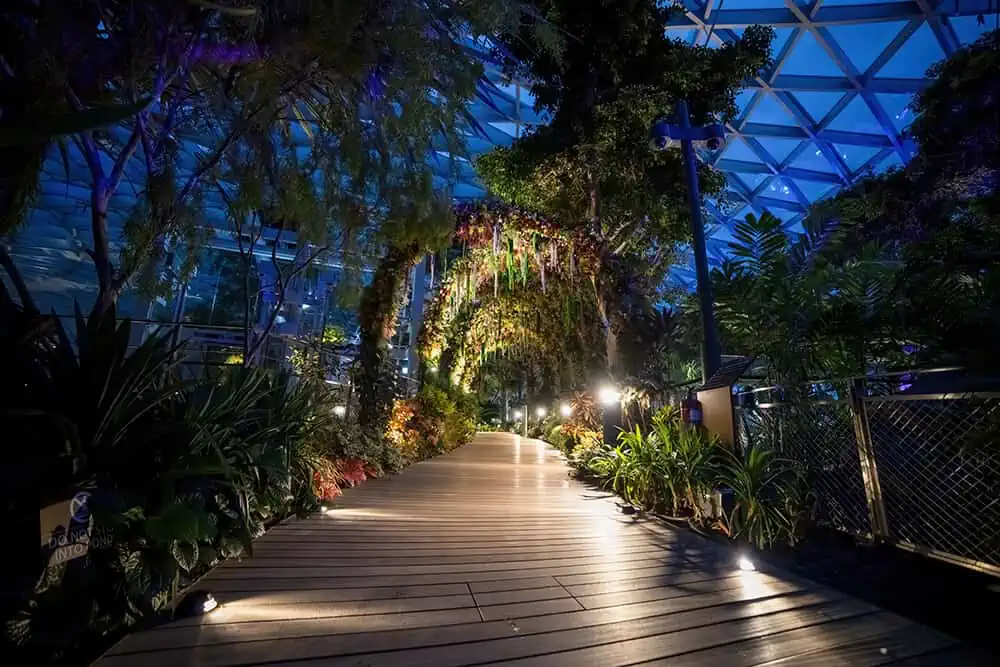
Types of Landscape Lights
You will find several fixtures in the market to implement the designs that we discussed earlier. Let’s find out the most common of them.
1. Path Lights
Path lights are installed to increase the visibility of the paths in landscapes. They allow you to stroll safely without hitting or stumbling on any obstacle. You can achieve it by in-ground lights or by installing small lamp posts along the paths. While you can also use incandescent and halogen lights, LEDs are best because they consume little power and offer high durability. You would not have to check on them or replace them every once in a while, which will be the case if you decide to go with cheaper and sub-par incandescent solutions.
2. Deck Lights
Deck lights are used on the patio for practical and aesthetic purposes. You can use the deck lights to shine a light on the different pieces of furniture from different levels. Furthermore, these lights can also be installed along the staircases within the houses and railings that lead to the open spaces on the roof of the houses.
3. Area Light
Area lights are used to create ambient light, which illuminates larger areas. You can use just the area of light in most landscapes to illuminate the entire area. However, such lights only have utility purposes and do not have a decorative role. You will have to install other fixtures along with it to make the landscape aesthetically appealing.
4. Floodlight
Like the area lights, floodlights are big lights that cover larger areas. Such light projects a wide beam that spreads over a larger area. Exactly like area lights, such lights are used to create ambient light, which is then decorated with other fixtures.
5. Spotlights
Spotlights are the polar opposite of floodlights as they project a narrow beam, which is concentrated and highlights only a specific part or element. You can use them to highlight a landmark inside the landscape or cast light on a tall tree. Such lights typically have more of a decorative role than a utilitarian one.
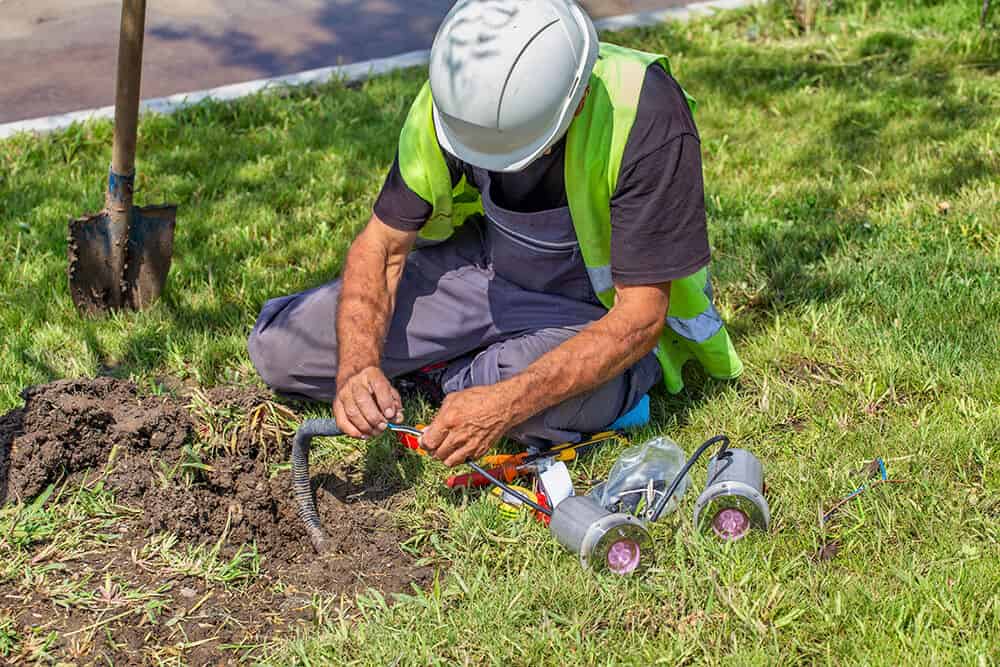
Tips for a DIY Landscape Lighting Project
Hiring professional services to design and implement landscape lighting conditions is better if you have a large landscape around your property. However, if your landscape is rather small, you can try to light it by yourself. Follow these steps to light your landscape without spending too much money on it.
1. Finalize a Design
The first step in lighting a landscape is to have a blueprint of lighting design in your mind. You should analyze the landscape and the elements inside and create a sketch in your mind. Once you know how you want each element in the landscape to look, you can proceed to the next step.
2. Find Suitable Bulbs
Once you have finalized the design, compare the different options that you have to implement it. As discussed earlier, the popular solutions include LEDs, Halogen, and incandescent bulbs. We recommend going with LEDs because they are not just cost-effective but also very flexible. You can find LEDs in all shapes, sizes, and colors. The range of LED options will help you easily achieve the design in your mind.
3. Find Good Quality LED Lights
If you have decided to go with LED lights, it is important to get the ones that offer the best quality. Unlike the lights in your interior, these lights will be subjected to harsh climate conditions, making them more durable than standard LED lights. Make sure they are rated for outdoors before picking a solution for the landscape.
4. Try Solar Lights
The most tricky part of installing landscape lights is wiring. You also have to conceal the wiring to protect it from wearing down because of UV rays. To do that, you will have to purchase appropriate wire and other elements to conceal it. However, this problem can be avoided altogether by using solar lights. These lights will charge themselves and will not require any wires.
Thus, you will save money on energy bills and make the process of installing landscape lights even more convenient.
5. Avoid Glare
An important thing to remember while lighting a landscape is not to overdo it. You should keep it subtle and avoid glare that can make you really uncomfortable during lights. There are various anti-glare fixtures that can be used, but they are generally expensive. If you are running on a tight budget, there are also some DIY solutions to reduce the glare from landscape lights.
FAQs
The amount of energy consumed by landscape lighting depends on the area of the landscape and the fixtures used to illuminate it. While traditional bulbs might come with inexpensive price tags, they will increase energy bills by many folds. Thus, you should use LEDs which consume less electricity and save on energy bills.
LED landscape lights add value to the property, make it look aesthetically appealing, and leave an impression on the visitors. All of it certainly makes them worth it.
You should leave the landscape lights on from dusk to dawn. To workaround the hassle, you can use sensors that detect sunlight and turn the lights off and on automatically.
It is advised to light the landscape by yourself if you have a large landscape. However, picking up good-quality solar light fixtures can light a small landscape.
The number of lights for a landscape depends on the area and the design you want to implement. One point to remember is that whatever you do, try to keep it subtle. You do not want the landscape to look like it is under direct sunlight at night.
The amount of value landscape lighting adds to the property certainly makes it worth it.
There are several factors that influence the cost of this replacement. You will have to consider the type of light, fixture, and supporting elements to get the exact figure.
The average price of landscape lighting ranges between $1,000 to $2,000. Several factors, such as the design of lights, the area of the landscape, and the property’s location, can drastically increase or decrease this price.
Related Articles
Landscape Lighting: The Definitive Guide
12 LED Landscape Lighting Trends You Need To Know About 2023
Conclusion
Landscape lighting is expensive, but for the value it adds to the property, the investment is certainly worth it. It is expensive mainly because the bulbs, wiring, and supporting equipment needed to install them have to be of good quality. They should have adequate weather resistance based on the location of the property.
While some of the factors that make landscape lighting so expensive cannot be worked around, knowing what makes it expensive will help you work around others. This article has tried to explain the factor that makes it costly and discussed ways to help you cut costs. We hope it has helped.
LEDYi manufactures high-quality LED strips and LED neon flex. All of our products go through high-tech laboratories to ensure the utmost quality. Besides, we offer customizable options on our LED strips and neon flex. So, for premium LED strip and LED neon flex, contact LEDYi ASAP!
